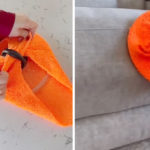A clothes dryer is a handy appliance for any household, especially during rainy or humid seasons. It simplifies the post-laundry process by eliminating the need for hanging clothes to dry and ironing them.
However, many people do not know how to use a dryer properly. Misuse of a dryer not only impairs its efficiency but also leads to unnecessary energy consumption and potential damage to your clothes.

Clothes dryer is a useful appliance in daily life, especially on rainy and humid days. (Illustrative image)
Here are some common mistakes people make when using a clothes dryer, as pointed out by manufacturers and distributors:
Putting in Wet Clothes
It is a misconception that clothes can be put into the dryer right after washing. This is entirely wrong. Wet clothes with excess water will not only prolong the drying process but also pose a safety hazard.
Excess water can drip directly onto the heating element and electrical wiring, potentially causing electrical shocks or fires. Make sure to spin-dry your clothes first, either by using a washing machine or manually spinning them.

Ensure clothes are spun dry before putting them in the dryer to avoid excess water. (Illustrative image)
Overloading or Underloading the Dryer
Whether it’s a dryer, washing machine, or dishwasher, using the appropriate amount of items is crucial. Overloading can lead to inefficiencies and potential damage, while underloading wastes energy.
Specifically, for dryers, putting in too few clothes can result in the items becoming balled up during the drying process. Manufacturers recommend filling the dryer to about 2/3 of its capacity for optimal performance.

The ideal amount of clothing for a dryer is approximately 2/3 of its capacity. (Illustrative image)
If you have a large amount of laundry, consider doing multiple loads or prioritizing essential items first. Overloading the dryer will lengthen the drying time and cause unwanted wrinkles.
On the other hand, if you have too few items, consider adding a few clean towels to avoid any issues during the drying process.
Not Sorting Clothes
Sorting clothes before drying is crucial. Different types of fabrics and thicknesses require specific drying programs and settings. Not sorting them means using a one-size-fits-all approach, compromising the dryer’s efficiency.

Sort your clothes according to fabric type and thickness to choose the appropriate drying program. (Illustrative image)
Sorting guidelines include separating denim and heavy towels, synthetic fibers, delicate fabrics, and underwear. This process also allows you to inspect your clothes for any foreign objects like keys, coins, or candy, which could damage the dryer or your clothes.
Pay close attention to metallic objects, sharp items, or sticky substances like gum, as they can cause harm to both the machine and your garments.
Leaving Clothes in the Dryer for Too Long
Once the drying cycle is complete, remove your clothes from the dryer and hang them up to air out. This helps reduce wrinkles and maintains the shape of your garments.

Take out your clothes promptly after the drying cycle to prevent wrinkles and shape distortion. (Illustrative image)
Leaving clothes in the dryer for an extended period may cause wrinkles and shrinkage due to residual heat. Additionally, avoid putting them directly into your wardrobe or wearing them right after drying. Allow them to cool down for about 10-15 minutes before storing or wearing.
Some dryers have a cool-down feature to help with this process.
Neglecting to Clean the Dryer
Just like washing machines, refrigerators, and dishwashers, clothes dryers require regular cleaning to prevent bacterial growth and maintain optimal performance and hygiene.
Over time, lint and dirt can accumulate inside the dryer, increasing the risk of fires and explosions. Therefore, it is essential to clean your dryer with soap and water at least once a month, depending on usage frequency.

Regular cleaning of the dryer is necessary to remove lint and dirt buildup. (Illustrative image)
Some modern dryers on the market today feature self-cleaning modes, making maintenance more accessible and convenient.
By avoiding these common mistakes, you can ensure that your clothes dryer operates efficiently and lasts longer.
According to Trí Thức Trẻ
The Ultimate Guide to Wrinkle-Free Clothes: A Revolutionary Appliance to the Rescue
Introducing an innovative solution for those unexpected moments when your iron betrays you or is simply non-existent: a creative approach to smoothing out those creases without the conventional iron. This alternative method is a game-changer, ensuring you can still achieve that crisp, polished look for your clothes.
The Do’s and Don’ts of Using an Induction Cooktop: A Guide to Safe and Efficient Cooking
“Induction cooktops have gained widespread popularity due to their numerous advantages. However, it is essential to ensure proper and safe usage. Join us as we explore the key considerations for using induction cooktops safely and effectively! Uncover the secrets to maximizing your cooking experience with this modern appliance.”
6 Things to Keep in Mind When Using a Clothes Dryer
Introducing the humble yet mighty appliance that ensures your garments are dried efficiently and prolongs their lifespan – the clothes dryer. However, many are unaware of the proper usage, which could be detrimental. Uncover the 6 essential tips to utilizing this appliance effectively and avoid potential pitfalls.
The Ultimate Guide to Cleaning Your Sofa with a Pan: A Viral Sensation with 80 Million Views
A revolutionary sofa cleaning method has taken the internet by storm. Thousands of people have tried and tested a unique technique shared by a Tiktoker, involving a pot lid and microfiber cloths. The online community is abuzz with confirmation that this unexpected approach truly delivers remarkable results.



































